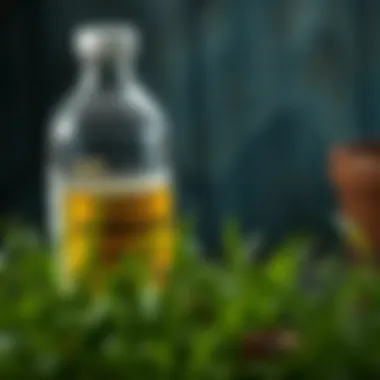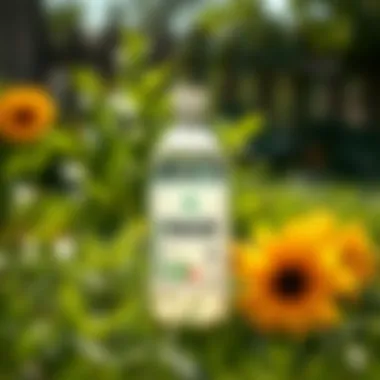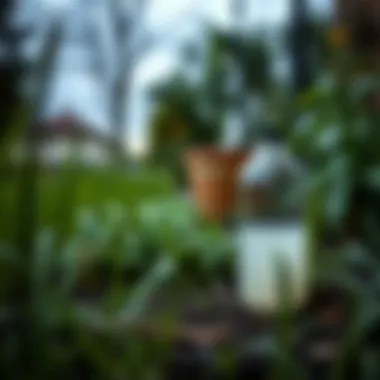Effective Homemade Grass Killer with Vinegar


Intro
In today's world, where sustainability takes center stage, the demand for eco-friendly solutions has never been higher. Many homeowners are on the lookout for natural alternatives to chemical herbicides, commonly resorting to various homemade grass killers. Among the most popular choices is vinegar, a pantry staple that packs a surprisingly powerful punch against unwanted greenery.
This article dives deep into the practicality of using vinegar as a homemade grass killer. We will break down the science behind its effectiveness, the preparation methods that can tip the scales in your favor, and important safety tips to keep in mind. Moreover, we’ll explore some alternative solutions for those who wish to broaden their gardening toolkit.
By engaging with this guide, homeowners and gardening enthusiasts alike will gain a thorough understanding of how vinegar can serve as an environmentally friendly weed control agent, allowing them to keep their lawns pristine without the negative effects associated with traditional herbicides. With that said, let’s embark on this exploration into the simple yet effective world of vinegar as a homemade remedy for battling unwanted grasses.
Understanding the Need for Weed Control
In the world of gardening, weeds are always the uninvited guests that refuse to leave. They sprout up anywhere—invading flower beds, smothering grass, and even competing with your prized vegetables for nutrients and water. This section navigates through why controlling these pesky invaders is not just important but necessary for a thriving garden.
The Impact of Weeds on Gardens
Weeds aren’t merely unsightly; they pose serious threats to the overall health of your garden.
- Competition for Resources: Weeds can steal sunlight, water, and nutrients essential for growth. If you’ve noticed your tomato plants struggling, you might want to take a closer look at the dandelions lurking nearby.
- Pest Magnet: Certain types of weeds may attract pests that could harm your prized plants. For instance, wild mustard can attract aphids, leading to a domino effect of infestations.
- Diseases: Some weeds host diseases that affect not only themselves but can transfer to your healthy plants. A garden filled with weeds can quickly become a breeding ground for fungi and bacteria.
"A weed is but an unloved flower."
– Ella Wheeler Wilcox
The pressing question arises: should homeowners let these unruly weeds take the reins, or is there a method to rid oneself of them? Gardeners must realize that untamed weed growth translates to disrupted ecosystems, which escalates into greater difficulty maintaining plant health.
Traditional vs. Organic Methods
When it comes to weed control, the traditional methods typically involve chemical herbicides notorious for their effectiveness but also their negative environmental impact. However, as the gardening world evolves, there's been a shift towards organic methods, like using vinegar for weed control. Here’s a breakdown of both methods:
- Traditional Methods
- Organic Methods
- Often quick-acting and efficient. Products like glyphosate kill weeds, but they can also harm beneficial plants.
- Health concerns regarding the long-term effects of chemicals on humans, pets, and the ecosystem remain valid.
- Emphasizes safer, eco-friendly solutions, using substances that naturally occur. For instance, vinegar is gaining traction as a suitable alternative.
- Although slow to show results, organic methods foster a healthier garden environment and support biodiversity.
As you can see, opting for organic methods like vinegar not only keeps the garden healthy but also aligns with sustainable practices. Understanding these fundamental aspects of weed control lays the groundwork for embracing a more holistic approach in subsequent sections. As homeowners and gardening enthusiasts, making informed decisions will pave the way for lush, vibrant outdoor spaces.
Vinegar as a Herbicide
When it comes to controlling that pesky greenery in your garden, vinegar stands out as a surprisingly effective herbicide. Understanding the role that vinegar plays in organic weed control can enhance your gardening efforts. From a scientific standpoint, vinegar’s ability to target unwanted plants makes it an eco-friendly alternative to traditional chemicals. It’s important to explore how vinegar reacts at a cellular level and the benefits it brings, especially for those looking to minimize their environmental footprint.
The Science Behind Vinegar's Effectiveness
Acetic Acid Concentrations
At the heart of vinegar’s herbicidal capabilities lies acetic acid, the main compound responsible for its potent weed-killing properties. The effectiveness of vinegar as a weed killer largely hinges on its concentration of acetic acid. Regular household vinegar sports about 5% acetic acid, which can be mildly effective for surface-level weed control. However, for real results, higher concentrations—around 20% or more—are often recommended.
High concentrations of acetic acid damage plant tissues, leading to dehydration and death. This makes it an effective choice for targeting weeds that sprout in unwanted areas. That said, using stronger concentrations comes with its own set of downsides, notably potential harm to desired plants and the surrounding environment. Careful application is crucial.
Impact on Plant Cells
When vinegar is sprayed onto a weed, the acetic acid penetrates the plant cells and disrupts their internal processes. This disrupts the cellular structure that is crucial for plant survival. Due to this disruption, the weed can no longer thrive, which ultimately leads to its demise.
This specific characteristic of vinegar is particularly attractive for gardeners who want to maintain a level of sustainability in their gardening practices. Yet, it’s vital to remember that the same mechanism that kills unwanted plants can also affect nearby desirable plants if not applied carefully. A good strategy is to target larger weeds directly and avoid spraying on windy days, minimizing unintended damage.
The Benefits of Using Vinegar
Eco-Friendliness
One of the standout traits of vinegar as a herbicide is its eco-friendliness. Unlike synthetic herbicides that can leave residue and potentially harm local wildlife, vinegar breaks down naturally, leaving no harmful remnants behind. This is particularly important for those who want to foster a diverse environment, encouraging pollinators and other beneficial creatures.
Vinegar’s non-toxic nature means that using it reduces the burden of chemical pollutants in soil and water systems. It's important for homeowners to note that just because it's a basic kitchen item doesn’t mean it can be taken lightly; proper application techniques are still necessary to ensure it serves its purpose without causing collateral damage.
Availability and Cost
Vinegar is widely available in grocery stores, making it a go-to option for those looking to manage weeds without breaking the bank. Whether it’s white vinegar, apple cider vinegar, or specialty vinegar like cleaning vinegar, options are aplenty, often costing much less than commercial herbicides.


When comparing against products from garden centers, vinegar shines due to its versatility and low cost. Not only can it kill weeds, but it can also be used in culinary applications and household cleaning. This multi-purpose functionality makes vinegar an attractive product to keep on hand.
Preparing Homemade Grass Killer
Preparing a homemade grass killer using vinegar is a simple yet effective way to tackle unwanted weeds without resorting to harsh chemicals. Understanding how to properly prepare this solution empowers homeowners to take control of their gardens in an eco-friendly manner. This section will delve into the essential components and considerations that make preparing this natural herbicide both beneficial and practical.
Choosing the Right Vinegar
Types of Vinegar
When it comes to choosing the right vinegar for your homemade grass killer, it’s crucial to understand the types available. White vinegar is often the most popular choice due to its high acetic acid content, usually around 5%. This type provides a potent punch against weeds without breaking the bank.
Apple cider vinegar, on the other hand, boasts additional nutrients and is popular for various culinary uses as well. While it has slightly lower acidity, its organic nature can appeal to those wanting to steer clear of synthetic options.
- Key characteristics:
- White Vinegar: Effective, budget-friendly.
- Apple Cider Vinegar: Nutrient-rich, organic.
Both types have their advantages and disadvantages. White vinegar works intensely on grasses and weeds swiftly, but with apple cider vinegar, you may find a subtler action that benefits some organic gardening practices, promoting soil health while targeting weeds.
Concentration Matters
The concentration of acetic acid in vinegar directly influences its effectiveness as a grass killer. Most household vinegars have an acetic acid concentration of around 5%, which can be quite effective on smaller, young weeds. However, using a higher concentration, like 20%, can dramatically increase efficacy, speeding up the weed destruction process.
- Key characteristics:
- 5% Acetic Acid: Ideal for lighter tasks.
- 20% Acetic Acid: Stronger, faster results.
It's worth noting that higher concentrations can also pose risks. Handling more potent vinegar requires more care; it can irritate skin or eyes. Always consider the specific needs of your garden and the potential trade-offs in strength versus safety.
Basic Recipe for Grass Killer
Now that you've selected the right type of vinegar and considered its concentration, it's time to move on to the recipe. Creating your homemade grass killer is straightforward and can be very satisfying.
Gathering Ingredients
To make this grass killer, you just need a handful of simple ingredients, which may already be in your pantry:
- Vinegar of your choice (white or apple cider)
- Water (depending on the concentration you’re aiming for)
- A few drops of dish soap (to help the mixture adhere to the leaves of the weeds)
This basic composition is not only easy to assemble but also economical. Selecting fresh, quality ingredients will further enhance the effectiveness of your mixture.
Mixing Instructions
Mixing your ingredients properly is essential for optimal results. Here’s how to whip up your own homemade grass killer easily:
- Choose your container: A spray bottle or garden sprayer works well.
- Combine the vinegar and water: If you’re using 5% vinegar, you might want to mix it with equal parts of water. For a stronger solution, go with a higher vinegar concentration.
- Add dish soap: A couple of drops will do, as this helps the mixture stick to the leaves more effectively.
- Shake it up: Ensure it’s well mixed before applying.
Following these steps will help ensure you’re maximizing the potential of your homemade grass killer while keeping the process simple.
Homemade recipes like this not only provide a safe alternative for weed control but also foster a stronger connection between gardeners and their efforts to create better, healthier environments.
Application Techniques
Understanding how to apply homemade grass killer effectively is crucial to achieving the desired results without causing harm to other plants or the environment. This section delves into the strategies that should be employed to make the most of vinegar's herbicidal properties. Proper application can maximize the impact on unwanted weeds while minimizing any potential repercussions on your garden.
Optimal Timing for Application
The timing of your application can greatly influence its effectiveness. By considering environmental factors like the weather and the time of day, you can enhance the performance of vinegar as a grass killer.
Weather Considerations
When it comes to applying vinegar-based weed killers, weather conditions play a significant role. Choosing a sunny day is often recommended, as the heat can help the vinegar evaporate, making it more potent against stubborn weeds. Sunny conditions tend to amplify the effects of the acetic acid found in vinegar, targeting the foliage effectively.


On the flip side, windy days bring the risk of drift. That means if you’re not careful, the vinegar could inadvertently touch nearby plants that you want to protect, leading to unwanted damage. A good practice is to check local forecasts for clarity. This can help you select a day with little to no wind.
Time of Day
The time of day you choose for application also matters. For many, applying early in the morning or later in the afternoon works best. This is when temperatures are moderate and sunlight isn’t overwhelmingly harsh. Applying during these periods can help prevent rapid evaporation of the vinegar, ensuring that it spends more time on the target weeds.
When tackling weeds in the heat of midday, the vinegar might evaporate too quickly, reducing its overall effectiveness. Timing your application around these key periods can potentially enhance your results significantly, allowing for a more efficient and successful approach to weed control.
Methods of Application
Understanding the methods of application is just as important as timing. The approach you take can impact how well the vinegar penetrates the weeds and, ultimately, your success in eliminating them.
Spraying Techniques
Spraying is one popular method for applying vinegar herbicide. Using a spray bottle or a garden sprayer can provide even coverage over large areas, hitting multiple weeds in one go. This method allows for precise targeting, which is particularly useful in densely populated areas where weeds are intertwined with desirable plants.
However, care must be taken to avoid overspray. A gentle mist is preferable; too much pressure can cause the vinegar to drift onto plants you intend to keep. A quick shake of the sprayer before use can help mix the solution evenly, improving its herbicidal effectiveness on the weeds.
Direct Application Tips
Another method is direct application, where vinegar is applied straight to the leaves of the weeds using a sponge or a cloth. This technique is especially useful for smaller patches of weeds, where precision is essential. Directly dabbing the vinegar onto the leaves minimizes the chances of affecting nearby plants, making it a more controlled approach.
Yet, this method can be labor-intensive, particularly for larger areas. However, it can be remarkably effective when dealing with stubborn weeds that require a more evaluated touch. Always wear gloves during this process to protect your hands from the acetic acid's effects.
Safety Considerations
When it comes to using vinegar as a homemade grass killer, safety is paramount. Understanding the risks associated with handling vinegar and its potential impact on desired plants can make all the difference between a successful weed control effort and an unfortunate gardening mishap. This section discusses the necessary precautions and strategies, ensuring effective and safe use of vinegar in your garden.
Handling Vinegar Safely
Personal Protective Equipment
Wearing the right personal protective equipment (PPE) is essential when using vinegar as an herbicide. PPE helps shield you from potential irritation that vinegar can cause. The most common types of protection include gloves, goggles, and masks.
- Gloves: These are a must, as vinegar can dry out and irritate your skin. Look for chemical-resistant gloves to provide a robust barrier between your skin and the acetic acid present in vinegar.
- Goggles: Your eyes are particularly vulnerable, and vinegar splashes can be painful. Goggles protecting against splashback are a popular choice among those handling vinegar regularly.
- Masks: While vinegar is not toxic in the way some chemicals are, inhaling the mist while spraying can cause discomfort or a stinging sensation in the throat. Using a mask can help minimize exposure when working with concentrated solutions.
Overall, wearing PPE is a beneficial approach to ensuring safety while utilizing vinegar in your gardening efforts.
Inhalation and Eye Contact
It’s essential to be aware of the risks of inhalation and eye contact when applying vinegar as a grass killer. The strong scent of vinegar can irritate your nasal passages and throat. If the mist from spraying gets too close for comfort, you may find yourself sneezing or coughing unexpectedly. Thus, providing ventilation is key.
- Inhalation Risks: Inhaling concentrated vinegar vapor can lead to respiratory discomfort. It’s wise to apply vinegar on windless days or to choose sheltered spots to minimize this risk.
- Eye Contact Risks: Vinegar splashing into your eyes can cause irritation or burning sensations. Close proximity to the application site should be avoided, and always refrain from touching your face before washing your hands.
Awareness of these factors can go a long way in ensuring a more comfortable experience when using vinegar-based solutions in your garden.
Impact on Desired Plants
When aiming to control weeds, it is crucial also to consider how vinegar affects your desired plants. You want to kill the unwanted ones without harming the ones you cherish. Understanding selective use strategies and preventing drift damage can help achieve this delicate balance.
Selective Use Strategies
Selective use strategies focus on applying vinegar only where it’s needed, lessening the chance of unwanted damage to your garden plants. There are several approaches you can take:
- Target Weeds Specifically: Instead of broadcasting vinegar across an area, use a spray bottle or a sponge applicator to target just the weeds. Being precise can substantially reduce the risk of affecting nearby plants.
- Dilution Options: In some cases, diluting vinegar can lower its potency. Test a diluted mixture on a small section of the weed to gauge its effectiveness before applying more broadly.
Selective use of vinegar remains a popular tactic due to its effectiveness in achieving specific weed control while safeguarding your desired flora.
Preventing Drift Damage
Drift damage can occur when vinegar mist moves away from the targeted application area, possibly harming other plants in the process. To prevent this:
- Wind Conditions: Pay close attention to the wind. Choosing a calm day for application will minimize the chance of drift. If it’s breezy, consider delaying your spraying.
- Use of Shields or Barriers: Physical barriers like cardboard or plastic sheets can be placed around desired plants to offer additional protection from any overspray.


By employing these strategies, you can gain better control over where your vinegar solution ends up, ensuring your gardening efforts yield positive results.
Effectiveness and Limitations
When delving into any method of weed control, whether it’s a family recipe passed down through the generations or a modern approach like vinegar, understanding the effectiveness and limitations becomes critical. This section evaluates how vinegar performs as a homemade grass killer while also identifying situations where it might not meet expectations. By grasping both its advantages and drawbacks, one can better manage their gardening needs in an eco-friendly manner.
Speed of Results
One of the first questions that come to mind is, "How quickly can vinegar get rid of unwanted grass?" Well, vinegars, especially those with a high concentration of acetic acid, can offer rapid results. Many gardeners report that the weeds start wilting within hours of application—much faster than traditional herbicides. This immediate impact can be a double-edged sword.
- Quick Satisfaction: Seeing the weeds droop within a day offers a certain gratification that many gardeners crave. It's like instant results after a long battle with stubborn plants.
- Impact on Weeds: However, it’s important to note that while vinegar can kill the visible parts of the plant pretty quickly, it often doesn't eradicate the roots effectively, especially with tougher weeds like dandelions. This means that a single application might not be sufficient, requiring repeat visits to the battlefield of your yard.
- Environmental Factors: Weather can play a significant role too. Applications during dry, sunny days tend to yield better quick results compared to overcast ones. Sunlight actually amplifies the potency of vinegar, that’s why many recommend mid-morning as a prime time for application.
Long-Term Effects on Soil and Plants
The allure of using vinegar might lead some to apply it liberally, but this brings forth essential considerations regarding its long-term impact.
- Acidity Levels: Vinegar can acidify the soil, which is beneficial in small doses for certain plants but harmful for others. A significant dip in pH can make it difficult for most plants to thrive. Gardens already rich in structure might find vinegar use counterproductive over time.
- Soil Health: Regular application can also influence soil health negatively by potentially disrupting microbial activity, essential for nutrient breakdown. We want our soil to be alive and kickin’, so overdosing vinegar can lead to less vibrant growth in the long run.
- Selective Targeting: This is where technique plays a vital role. If you aim for certain weeds, being cautious not to spray desired plants will help maintain the overall harmony of your garden. Targeted application reduces the risk of unintended damage.
By understanding how vinegar works and its limitations, gardeners can make informed decisions on when and how to use this homemade grass killer effectively.
Thus, while vinegar presents a compelling case for quick weed control, careful consideration must be given to its long-term implications, weighing the immediacy of results against the health of your garden’s ecosystem.
Alternative Organic Weed Control Methods
In the quest for seamless gardens filled with lush plants, effective weed control cannot be overlooked. Many gardeners are turning away from harsh chemicals towards organic solutions that are not just better for the environment but often just as effective. Using alternative organic weed control methods like the salt and soap mixture and boiling water treatment can offer potent solutions to weeding woes without leaving a chemical footprint.
While vinegar is already an excellent natural herbicide, it's worth recognizing the herbs of both zeal and caution that come with it. When you step into the garden, you might realize that the old adage rings true: an ounce of prevention is worth a pound of cure. Not all plants and gardening philosophies mesh well with every killing method. So, let's dive into two alternative methods that might just save your garden without compromising your eco-friendly mantra.
Salt and Soap Mixture
The magic of a salt and soap mixture lies in its simplicity and efficiency, making it an attractive option for homeowners. Here are some key points to consider:
- How It Works: The salt works by drawing water out of the plant cells via osmosis, leading to dehydration. Meanwhile, soap helps this concoction adhere to the plants, ensuring better coverage and effectiveness.
- Ingredients Needed: The basic recipe involves combining table salt and liquid soap (like dish soap) mixed with water. Keep it at that; you want it straightforward. A typical mixture involves 1 cup of salt, 2 tablespoons of soap, and a gallon of water.
- Application Technique: You can spray this mixture directly on the leaves of the weeds. If you do this on a sunny day, results can be accelerated. Just be cautious; salt can impact the surrounding soil and nearby plants, so selective application is key.
"Using too much salt can lead to soil salinity, which may harm your desired plants for seasons to come." – Gardening Wisdom
- Considerations: As effective as it is, this method can also be unforgiving. It’s great for those hefty weeds, but too much salt can turn your garden into a no-plant zone. Long term, it can alter your soil's health, so use it wisely and sparingly.
Boiling Water Treatment
The boiling water treatment is perhaps the most straightforward warrior in the fight against weeds, and its effectiveness will surprise you. The beauty of this method lies in its accessibility and ease of use:
- How It Works: The sheer heat of the boiling water scalds the weeds. It disrupts their cellular structure, virtually cooking them alive in mere moments. This method is especially effective on annual weeds and smaller invasive plants, typically those pesky offenders that love to grow between the cracks in your sidewalk.
- Method: Simply bring a pot of water to a rolling boil and take caution as you pour this over the unwanted weeds. Aiming for the base of the plant gives you the best chance at tackling its roots.
- Benefits: Besides being an immediate solution, it’s chemical-free and poses minimal risk to the surrounding soil and plant life. Plus, it's suitable for nearly every outdoor setting, including patios, driveways, and garden beds.
- A Word of Caution: Like the salt solution, you need to be mindful of where you apply this method. Given its high temperature, it may inadvertently harm desired plants nearby if you’re not careful.
Combining diverse organic methods not only fosters a healthier gardening practice but also invites an experimental spirit aligned with nature's rhythm. When facing stubborn weeds, it's imperative to choose your weapons thoughtfully. Salt and soap or a scorching splash of boiling water could very well be the tool you need in your arsenal against unwelcome greenery.
Closure and Recommendations
In navigating the complexities of weed management, particularly through the use of vinegar as a homemade grass killer, it's prudent to step back and evaluate the various elements at play. This section encapsulates the core takeaways while guiding you on how best to incorporate vinegar into your gardening practices effectively and safely.
Understanding the importance of organic weed control cannot be overstated. With increasing awareness about environmental sustainability, many homeowners are seeking solutions that align with eco-friendly principles. Vinegar offers an effective alternative, especially when you approach it with care and foresight.
Evaluating Your Approach
Before diving into the application of vinegar as a grass killer, it’s necessary to assess your unique situation. Here are some factors to consider:
- Weed Type: Different weeds respond differently to vinegar. Some hardy varieties might withstand lower concentrations, while softer weeds could succumb swiftly.
- Area of Application: Consider where you're applying vinegar; adjacent flowers or vegetables are at risk of damage due to its non-selective nature.
- Frequency and Timing: Pay attention to the perfect timing for herbicide application—warm, sunny days can enhance its effectiveness, while damp conditions might dilute its potency.
- Long-term Strategy: Think about what will follow the vinegar application. Are you planning to replant grass, or will you be seeking a different solution? Planning ahead can save a ton of hassle down the line.
In brief, making a careful assessment of your situation allows for a more tailored strategy. This way, you're not just applying a broad stroke solution but one that meets the specific needs of your garden.
Incorporating Vinegar Safely into Your Garden
Though vinegar is generally regarded as safe compared to traditional herbicides, safe handling and application are crucial. Keeping these best practices in mind will help you harness the full potential of vinegar while minimizing risks:
- Use Proper Concentrations: Aim for a 10-20% acetic acid level for optimal results. Standard kitchen vinegar at 5% is often less effective for serious weed problems.
- Personal Protective Equipment (PPE): Even with a natural herbicide, protective gear is wise. Gloves and goggles prevent irritation and protect against accidental splashes.
- Target Application: Use a spray bottle or a brush to apply vinegar directly to unwanted weeds, avoiding contact with desirable plants. This method reduces the likelihood of unwanted collateral damage.
- Observe Weather Conditions: Refrain from applying vinegar before it rains, as this could wash away its weed-killing effects. Instead, choose dry, still days to apply your homemade solution.
In essence, wielding vinegar as a weed killer requires a mindful approach. Armed with the information highlighted in this article, you can venture into your gardening with the confidence that you’re adopting a method that is both effective and considerate of the environment. While vinegar may not be the silver bullet for every weed dilemma, it stands tall in the realm of organic solutions, promising a greener and more sustainable approach to garden care.
Remember, gardening is a journey, not a race. Celebrate each step you take toward more sustainable practices!







